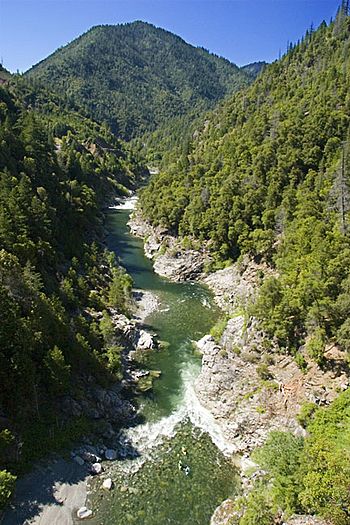Salmon River (California) facts for kids
Quick facts for kids Salmon River (California) |
|
|---|---|

Salmon River, California above the Wooley Creek confluence.
|
|
| Country | United States |
| State | California |
| Physical characteristics | |
| Main source | Confluence of North and South Forks Forks of Salmon 1,180 ft (360 m) 41°15′24″N 123°19′24″W / 41.25667°N 123.32333°W |
| River mouth | Klamath River Somes Bar 477 ft (145 m) 41°22′40″N 123°29′34″W / 41.37778°N 123.49278°W |
| Length | 19.6 mi (31.5 km) |
| Basin features | |
| Basin size | 751 sq mi (1,950 km2) |
The Salmon River is a beautiful river in northern California. It flows for about 19.6 miles (31.5 km). This river is a branch of the larger Klamath River. It is located in western Siskiyou County, California.
Contents
Where the Salmon River Flows
The Salmon River starts high up in the mountains. These mountains include the Trinity Alps, Russian Mountains, and Marble Mountains. All of these are part of the bigger Klamath Mountains range.
How the River Forms
The Salmon River actually begins as two main parts. These are called the North Fork and the South Fork. They meet together at a small place called Forks of Salmon, California. From there, they form the main Salmon River.
A large stream called Wooley Creek also joins the main river. It flows into the Salmon River about 4 miles (6.4 km) from where the Salmon River ends. Wooley Creek is almost as big as the North Fork of the Salmon River. The lower part of the Salmon River's path helps mark the border between Siskiyou County and Humboldt County.
The Salmon River's Natural Area
The area that drains into the Salmon River is called its watershed. This watershed covers about 751 square miles (1,945 km²). Almost all of this land is inside the Klamath National Forest. Less than two percent of the land is privately owned.
Protected Wilderness Areas
Nearly half of the watershed is protected as wilderness. This includes parts of the Trinity Alps Wilderness to the south. It also includes the Russian Wilderness to the east and the Marble Mountain Wilderness to the north. These areas are kept wild and natural.
Another big part of the watershed, about 25 percent, is a special area. It is managed to help old-growth forests grow and thrive. These forests are very important for many animals.
Wildlife and River Health
The Salmon River is special because it flows completely free. Unlike many other large rivers in California, it has no dams. There are also no major diversions that take water away. This makes it one of the cleanest and most natural rivers in the Klamath River system.
Home to Many Fish
The Salmon River is a very important home for fish. It has the only healthy group of wild spring Chinook salmon in the entire Klamath watershed. It also provides excellent habitat for other fish. These include steelhead, green sturgeon, rainbow trout, and Pacific lamprey.
Wild and Scenic River Status
The main Salmon River, its North Fork, South Fork, and Wooley Creek are all part of the National Wild and Scenic Rivers System. This means they are protected by the government. They were given this special status in 1981. This helps keep them clean and wild for future generations.
Challenges from Wildfires
Wildfires are a natural part of this area's ecosystem. However, they are now a big threat to the river and its watershed. In the past, people tried to stop all fires. This caused a lot of dead wood and plants to build up. Now, when fires do start, they burn much hotter and more intensely.
Large fires have happened often, including in 1977, 1987, 1994, 2006, 2008, 2013, 2014, and 2017. These fires cause more erosion. Erosion means soil and rocks wash into the river. This extra sediment makes the water muddy. It harms the habitat for fish like coho salmon, Chinook salmon, sturgeon, and steelhead.

